 |
| |
COMIC
PACKS
THE
STORY OF THE ORIGINAL COMIC BOOK IN A BAG
MARVEL
MULTI-MAGS
|
| |
|
 |
| |
1961/62
COMIC BOOKS SEALED IN A PLASTIC BAG ARE BORN
|
| |
| The story of those sealed
plastic bags containing between five and two different
comic books and sold as a package at a marginal discount
in supermarkets and department stores began on November
30th 1961. The reason why this can be pinpointed
down in such a precise way is because it was National
Periodical (i.e. National Comics, i.e. DC Comics) who
came up with the idea, and being the orderly and well
organized publishing company DC always was, submitted the
name COMICPAC for trademarking - with the purpose to
produce, market and sell "packaged comic
books". A groundbreaking new concept opening up new
market opportunities and planting the seeds of what would
become the direct market, "comicpacs" quickly
became a highly successful business for DC.
This was in sharp contrast to
the increasingly difficult task of selling comic books
through newsstands and the traditional but
frustratingly unprofitable setup of reimbursing resellers
for unsold items (a business model which of course
did nothing whatsoever to encourage actual sales). It was thus only a matter of time before
other publishers would try and start to copy DC's Comicpac
concept. The opportunity to do so came when the well
established Whitman company (a division of Western
Publishing) took over the distribution of DC's packaged
comics to supermarkets in 1967, inviting a quickly
growing number of additional publishers to join in.
|
| |
1968
THE COMING OF THE MARVEL MULTI MAGS
|
|
| |
| Successful
and innovative Marvel Comics had just grabbed the market
leader position from DC early that year, and the House of Ideas tuned in on the
Whitman distribution deal to supermarkets and chain
stores too. As DC had copyrighted its COMICPAC, Marvel Comics - just like all other
publishers - had to come up with their own name for their
packaging. Sticking with Stan Lee's love for
alliterations Marvel labelled its comicpacks MARVEL MULTI-MAGS and used the character vignette in a box
(a Steve Ditko brainchild) to help buyers who were in the
know identify quickly which titles they were getting. |
| |
 |
| |
| DC was very methodological about their COMICPAC
concept and issued a total of 24
sets of comicpacs per year throughout the 1960s like
clockwork - two each month. Each Comicpac was coded A and
B respectively and numbered 1 to 12. By 1964 the digit
would refer to the month, i.e. A-1 and B-1 would both
feature comic books with a January cover date, and they
would always contain exactly the same titles (e.g. the
1965 B-3 Comicpac would carry the same four issues no
matter where or when it was sold) - an indication of how
organized and structured the comic packs business at DC
was. Initially,
Marvel followed both the DC output and coding system (an
A and B Multi-Mag a month) and even expanded it by adding
the year, e.g. Multi-Mag 68-A10 would designate the first
packaged set sold in October 1968. The first known Marvel
Multi-Mag dates from July 1968 and contains issue #62 of Amazing
Spider-Man - a title which is well represented in
the roughly a dozen known Marvel Multi-Mags from 1967/68.
|
| |
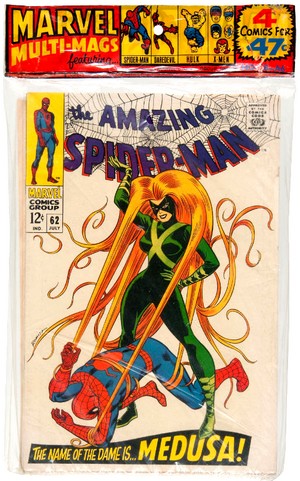 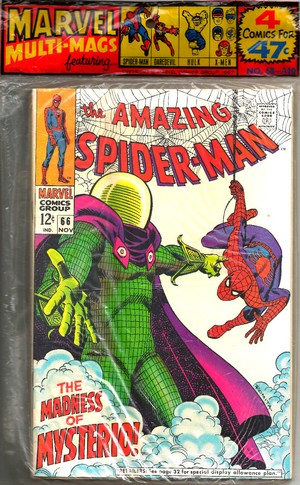 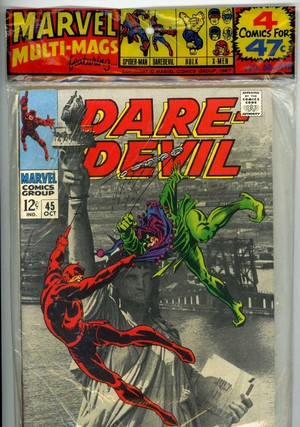 |
| |
Marvel
Multi-Mags 68-A6 with Amazing Spider-Man #62 (July 1968)
[left]
Marvel Multi-Mags 68-A10 with Amazing Spider-Man #66 and
Daredevil #45 both November 1968) [center and right]
|
| |
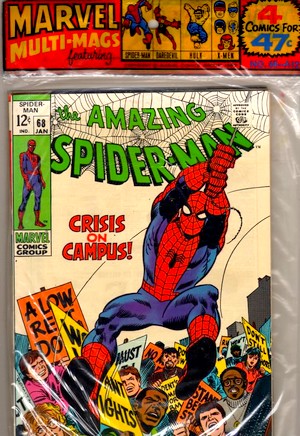 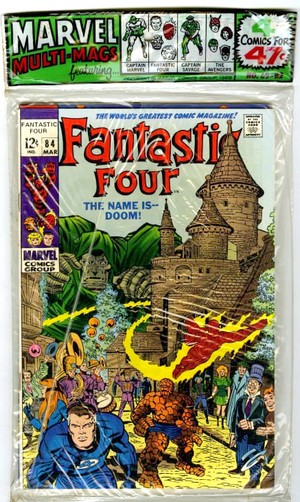 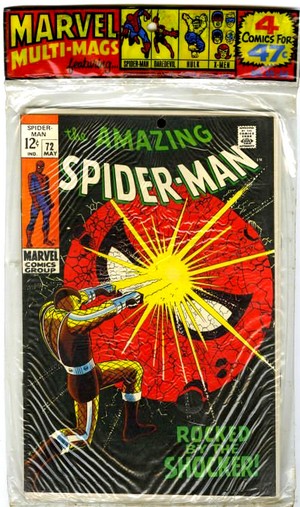 |
| |
Marvel Multi-Mags 68-A12
with Amazing Spider-Man #68 (January 1969) [left]
Marvel Multi-Mags 69-B2 with Fantastic Four #84
(March 1969) [center]
Marvel Multi-Mags 69-A4 with Amazing Spider-Man
#72 (May 1969) [right]
|
|
| |
| |
1969
MIND THE GAP
Marvel's Multi Mags had
been around for little more than a year when all
of a sudden they simply vanished in mid-1969.
The reason was twofold.
Firstly, Martin Goodman
had sold Marvel Comics in July 1968 to Martin
Ackerman who ran a business conglomerate called
Perfect Film & Chemical Corporation (Howe,
2012).
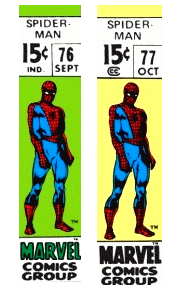 |
|
Secondly, Perfect Film
had also acquired Curtis Publishing with
its own distribution division, Curtis
Circulation. Marvel had already changed
printers in May 1969 (Saunders et al,
2008), and when Marvel's distribution
contract with Independent News expired,
Curtis Circulation took over (Howe,
2012). The cover
date production run for October 1969 - on
sale in mid-July 1969 - heralded the
change. Gone was the long-standing IND
below the price, replaced by the rounded CC logo
of Curtis.
It pointed to
doing all things "in-house" in
order to maximize profits (ironically at
a threshold point in time when comics
were starting to lose money).
Perfect Film's
approach to doing business was such
(Howe, 2012) that it is safe to assume
that the Whitman distribution deal simply
expired alongside the contract with
Independent.
|
|
|
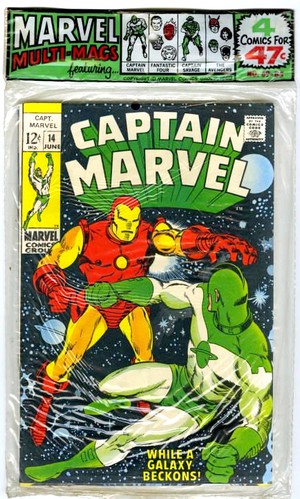
Marvel
Multi-Mags 69-B5 with
Captain Marvel #14 (June 1969)
|
|
| |
| So in spite of the continuing
success of DC's COMICPACs (which
became SUPER PACs in 1970) and
other publisher's packaged comicpacks,
Marvel seemingly dropped out of the market quickly - and
completely - for quite some time. |
| |
1972
THE RETURN OF THE MARVEL MULTI MAGS
|
| |
| An ongoing compilation of known
Marvel Multi-Mags shows the next evidence of one on
sale to be a packaged bag from October 1972 with 4 comics
(Iron Man #51,
Daredevil #92, Hero For Hire #3 and
Adventure Into Fear #10) selling for 79¢. |
| |
| Data
regarding Marvel's MULTI-MAGS is currently derived entirely
from known existing examples, and unfortunately lacks any
systematic foundation that could be gained from
production or distribution lists. Attempting to analyze MARVEL MULTI-MAGS could therefore be likened to
the task faced by an archaeologist; the overall picture
is based on inference in an attempt to fill in the blanks
and gaps. |
| |
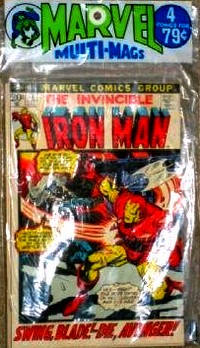
October 1972
|
|
It is reasonable
to assume that the comicpack
formula was dropped at Marvel
after the switch to Curtis
Circulation, given the complete
lack of any evidence for Marvel
Multi-Mags between October 1969
and October 1972. The new logo
(which would be used consistently
up until the early 1980s) is in
evidence for the first time on
the aforementioned October 1972
4-pack. However, things remain
very muddled and sketchy when
looking at the early 1970s. Current
data only
documents a total of two examples
of MARVEL MULTI-MAGS each
for 1972 (October and December)
and 1973 (February and September),
and the numbers remain very low
for 1974 (four) and 1975 (nine).
It is only as of 1976 (with
twenty known different MULTI-MAGS
examples) that the data becomes
somewhat more stable and allows
for some amount of analysis.
It is
difficult to say whether the
production and distribution of
Marvel Multi-Mags at the time was
only sporadic or simply took
place in small circulation
numbers, leaving only very few
surviving examples for posterity.
But then things in general became
rather chaotic at the House of
Ideas.
Perfect
Film still owned Marvel but had
renamed itself Cadence Industries
in 1973, and what had officially
been Magazine Management Company
now officially became known as
Marvel Comics Group (Nadel,
2009), of which Albert Landau
became president that same year
(Howe, 2012).
|
|
|
|
| |
| Unlike Stan Lee, whom he succeeded in that function,
Landau had no comic book industry background and had
previously been running a photo agency which occasionally
worked together with Magazine Management Company. But
what counted was that Landau was the choice of Cadence
CEO Sheldon Feinberg. Described by Stan Lee as "a
very strange guy" (Lee & Thomas, 1998),
Landau - under whose reigns work culture at Marvel
gradually became dysfunctional and demoralizing (Howe,
2012) - kept turning in estimated sale figures to the
Cadence top brass which increasingly looked just too good
to be true. Growing suspicious, the corporation sent
an accountant and one Jim Galton, a circulation
consultant, over to Marvel to examine the profit-loss
statements whilst Landau was on vacation. What they found
deeply troubled Cadence, and they made Galton replace
Landau as president with immediate effect in 1975 (Howe,
2012).
The
accountancy books revealed that Marvel had lost $2
million by mid-1975 (Daniels, 1991). On top of
that, Galton quickly found out that Marvel published 75
comic books each month but that hardly any of them were
ever distributed on time. Fans never knew if and when the
next installment of their favorite stories would reach
them. So Galton's first mission was to establish serious
deadlines and enforce them (Foerster, 2010).
Another huge problem was the
traditional distribution model with returnability - and
the fraudulent practices it attracted.
"We actually found a
company that was sending back more copies than we
shipped them. We found out there was a printer in
upstate New York that was printing copies of our
covers to sell back to us (...) At the time we had
something like a 70 percent return rate"
(Galton in: Foerster, 2010)
Galton adressed the distribution
problems and, ultimately guiding Marvel into the direct
market, seemingly also rediscovered the virtues of the
sealed, non-returnable comicpack bag and its special
market with a customer base in supermarkets and
department store chains which comic books could hardly
reach otherwise.
|
| |
| By late 1975, Marvel was
back in the comicpack business (as the
rising number of known Marvel Multi-Mags
indicates), but their offerings would
never be as structured and adhering to a
corporate design such as DC's comic packs
- which kept on being turned out in 4
different sets every month throughout the
1970s like clockwork (occasionally adding
a fifth set outside the regular schedule) Which raises the
question who actually ran and distributed
the Marvel Multi-Mags scheme. Given the
prominent MARVEL plus Spider-Man branding
(plus trademark indication) it all seems
to point to Marvel itself being at the
wheel.
Which may also
explain why there is only anecdotal data
at hand for the actual publication
schedule - although there are confirmed
multiple sets of Multi-Mags for a number
of months from 1975 through to 1981.
Given that the topic has not been the
subject of much reserach in the past,
more information might come to light yet
which could reveal an actual systematic
behind Marvel's Multi-Mags.
During the initial
phase the MARVEL
MULTI-MAGS logo printed onto the
header of the plastic bag was used
consistently, but in various colour
variations: red and blue on white, yellow
and green on white, green and black on
yellow, and yellow and white on red were
all used at times - although the visual
branding used (Spider-Man over a circular
vignette) only really worked with a blue
background. Quite obviously, Spidey's
costume was popular and known enough to
withstand even the most garish colour
combinations.
During this early
direct market attempt the comic books
sealed inside the plastic bags were
simply taken from the regular newsstand
print run, i.e. they differed in no way
from an issue sold in the context of the
old returnability scheme. This was true
across the board for all publishers who
now sold their comic books packaged as
comic packs, but as successful as this
distribution and sale scheme was, DC,
Marvel and Charlton (who all used
Whitman's comicpack distribution system)
gradually became aware of the fact that
they now faced a new problem.
|
|
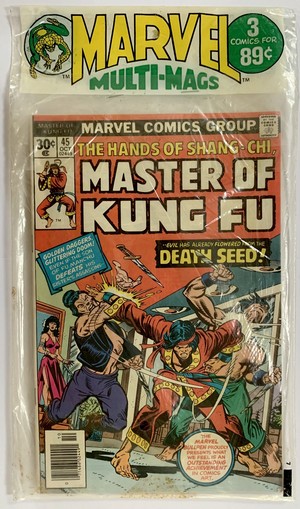
October 1976
|
|
|
| |
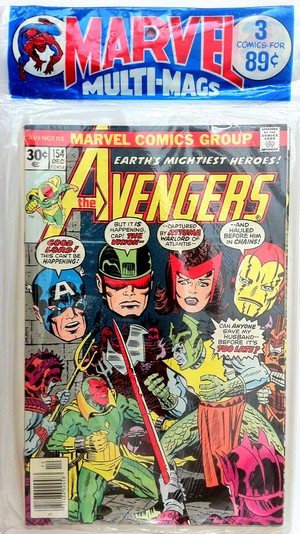 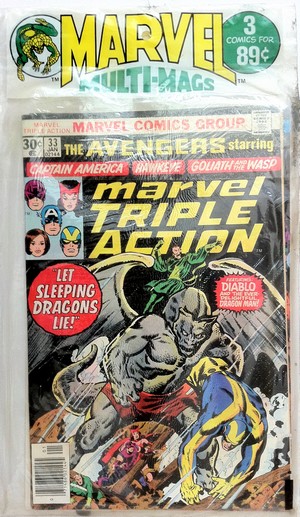 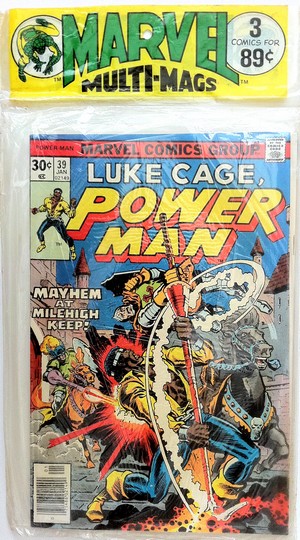
December 1976
[left], January 1977 [center and right]
|
| |
Comic packs were distributed to and sold by a large
variety of outlets, including some who also carried
regular newsstand comic books. And the aforementioned
crookedness of parts of the newsstand sales business
found an easy way to get around the non-returnability of
bagged comic books.
"A certain number of
distributors and retailers simply split the packs
open and returned the loose comics, making an
arbitrage profit." (Paul Levitz in:
Evanier, 2007)
But it wasn't just the vendors -
it was the customer side too.
"We called 'em Marvel
Multi-Mags, and they were three Marvel books in a
plastic bag for a cent less than the full cover
price. These things used to be everywhere - in
grocery stores, in toy stores, and in department
stores. It always took facile fingers to pry the bag
apart just enough so that you could see the middle
comic that was sandwiched in-between - if you were
scrupulous, like me - those less pure of heart would
just rip the bag apart in the store and take what
they wanted." (Tom Brevoort in: Morse, 2008)
DC, Charlton and above all Marvel
- where Galton was still looking to fix every hole in the
bucket he could find - must have rightfully been quite
annoyed by all of this, even more so as it was a tough
problem to tackle. Until you took a look at how Whitman
themselves handled their own comic packs, that is.
|
| |
| Whitman acquired the
rights to the comic books from its parent
company (Western Publishing) which they
distributed in packaged form. As a result, Whitman
was selling comic book packs as of 1972
containing Gold Key titles which had
their logo replaced by the familiar
"Whitman face". As a side
effect, it was thus always possible to
tell a regular newsstand Gold Key comic
book from the same issue coming from a
comic pack.
|
|
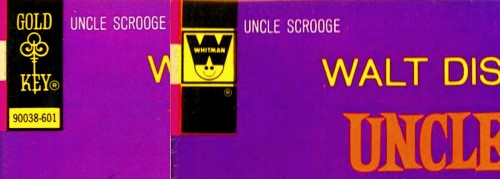
|
|
|
| |
| It was the fix everybody was
looking for - an easy and inexpensive way of tackling the
problem of dishonest sellers ripping open the plastic
bags and making a double profit by returning the
contents. |
| |
1977
ENTER THE "WHITMAN MARVELS" (DME)
|
| |
| In February 1977, Marvel followed
the principle of this procedure, but - as Whitman only distributed
Marvel comics but didn't buy the rights to any
of them - had to come up with its own design to
differentiate comic books distributed in comic packs from
regular returnable newsstand issues. |
| |
 |
| |
| The tell-tale sign which Marvel
introduced on their packaged comics was a large white
diamond on a black background in the upper left-hand
corner, replacing the established price plus number /
month fields and dropping the Curtis CC
(which made sense as the diamond marked a copy
distributed by Whitman). |
| |
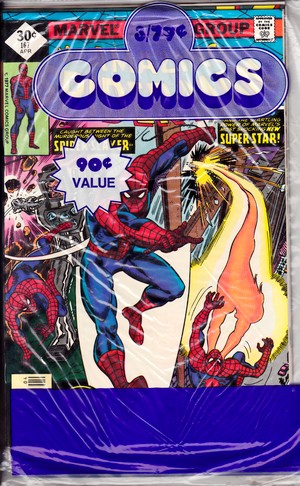
April 1977
|
|
MARVEL
MULTI-MAGS
continued to be sold in
parallel, unaltered,
carrying newsstand
edition comic books -
which would seem to
indicate that Marvel was
now simply using two
packaging and
distribution channels:
one was Whitman, and the
other possibly the House
of Ideas itself. It would
not be surprising if
Marvel - just like DC -
did not hand Whitman a de
facto monopoly on their
comic packs and kept some
of it to themselves. The
example here - using one
of the standard Whitman
bags without branding
other than COMICS
- contains Amazing
Spider-Man #167, Incredible
Hulk #210, Thor
#258 from April 1977,
priced at 30¢ each
but selling for 77¢ (which
was a much better bargain
than any Multi-Mag would
ever offer). All
three titles would
feature frequently in
Marvel comic packs
throughout the 1970s.
Often
called "Whitman
Marvels", these
comic books were
absolutely identical to
their newsstand edition
cousins apart from the
white diamond - and the
very first Direct Market
Editions (DME) from the
House of Ideas.
"Bagging
comics made it affordable
to painlessly introduce
the first Direct Market
Editions without
resorting to expensive
small print runs."
(McClure, 2010)
The
"Whitman
diamond" appeared on
Marvel comics cover dated
from February 1977 to
April 1980, with the
exception of three gaps
in printing: January to
March 1978, July 1978,
and March/April 1979
(McClure, 2010).
Surprisingly,
however, Marvel's
Multi-Mags remained
untouched by this
development and continued
to contain comic books
not marked with the
special direct market
"Whitman
diamond".
|
|
|
|
|
| |
| Those which did were distributed
by Whitman / Western in a variety of bags with changing
designs. Initially using their standard "3/77¢" bags shown left, this changed in
mid-1977 to their standard "CoMic PaC" bags
(and an increase of price to "3 for 89¢"), examples of which are
shown below. |
| |
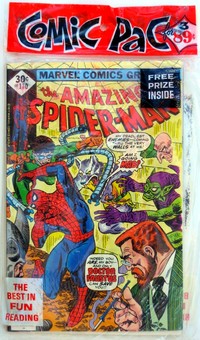
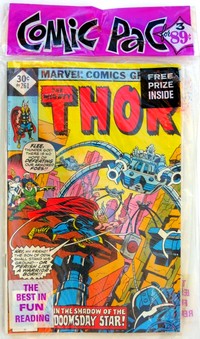
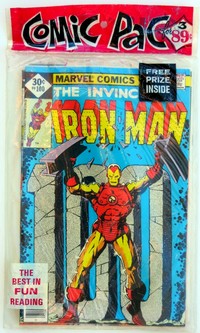
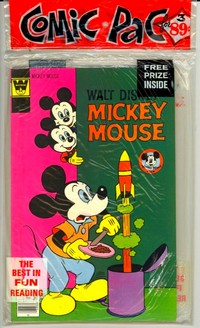
|
| |
| These
1977 Whitman "Comic
Pacs" with diamond
cover Marvels also
illustrate how Western
had no problem using the
same bag for completely
different content (or did
they actually have a
crystal ball and foresaw
the future purchase of
Marvel by Disney...??). The
hanger label was used in
different colours and
there are known cases
where a change in colour
meant that two seemingly
identical "Comic
Pacs" (i.e. with the
same outside comic books)
actually contained a
different Marvel title in
the middle.
The phenomenal
success following
Marvel's launch of their Star
Wars monthly title
in July 1977 (originally
floated to Stan Lee by
Lucasfilm and pulled
through by Roy Thomas
against a lot of initial
opposition at Marvel) not
only saved Marvel Comics
(Shooter, 2011) but
opened up what was simply
a phenomenal sale base
for a comic book.
"Star
Wars the movie stayed in
theaters forever, it
seemed. Not since
the Beatles had I seen a
cultural phenomenon of
such power. The
comics sold and sold and
sold. We reprinted
the adaptation in every
possible format.
They all sold and sold
and sold."
(Shooter, 2011)
The Star
Wars phenomenon
fitted the comicpacks
idea perfectly, and
Whitman quickly jumped
onto the idea of
packaging bags which only
carried Star Wars
issues. Selling
exceptionally well (even
though the first batch,
in the standard
"3/77¢"
bag, actually contained 30¢
priced issues
#2, 3 and 4, making
buyers miss #1)
Whitman
realized that sales could
be maximized through
branding - enter the
first STAR WARS bag,
containing the first
three issues (priced
35¢) for
99¢.
Star
Wars spearheaded
a new comicpack formula
as Whitman now took to
selling packaged bundles
of three issues with
continuous numbering.
This included later
adaptations of third
party properties by
Marvel such as Battleship
Galactica, Micronauts,
Transformers and
Shogun Warriors.
Based
on the success of the
dedicated Star Wars
comic packs, Whitman also
began to package
character themed bags
which typically featured
three consecutives issues
of one title, again using
clear brandings for the
characters, as well as
now clearly indicating
the distribution through
Western (Whitman). Other
than Thor (1978)
and Conan (1979)
(examples below) Whitman
also sold several Spider-Man,
Captain America
and Tarzan packs
for Marvel (Whitman also
produced a number of Batman
and Superman
packs for DC, which
however carried the
Whitman face logo instead
of the DC bullet).
|
|
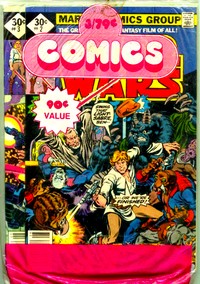
Star
Wars 3-Packs (1977)
(source:
www.bipcomics.com)
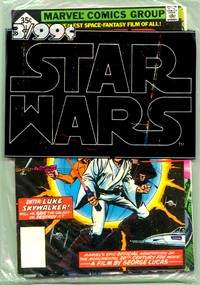
|
|
|
|
|
| |
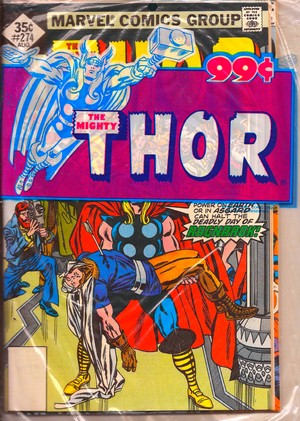
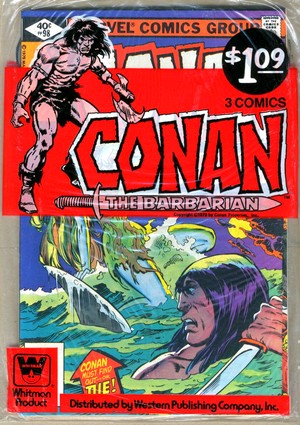
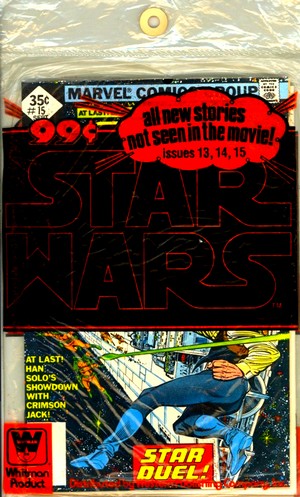 |
| |
1978 - 1979
THE MULTI-MAGS MARCH ON
|
|
| |
| The Whitman packaging and sales machine for bagged
packs of comic books was well oiled, but both Marvel and
DC did not feel like relying on just one distributor for
their packaged comics. Whilst DC maintained a well
organized and groomed system throughout the 1970s (first
called SuperPac, then Dynamic Comics, Dynamite
Comics, and finally DC Super Heroes),
Marvel's Multi-Mags continued to be an unpredictable
product (which, in many ways, reflected the prevalent
problems inside Marvel itself) but one which would be
hanging around (no pun intended) for quite some time
still. The Multi-Mags continued to contain unaltered
newsstand editions - a practice which would continue even
after Marvel had started to send diamond cover issues
only to subscribers and comic shops (i.e. direct sales
destinations) as of June 1979 - and now sold 3 comics for
99¢. And other than the
established titles (which had a brand character
recognizing force even with parents and grandparents who
didn't know much about comics but who often bought the
comicpacks for their children and grandchildren) such as Spider-Man
(both Amazing and Spectacular),
Captain America, Thor, Fantastic Four
and Iron Man, the Multi-Mags would occasionally
feature other interesting titles such as Marvel
Team-Up, Marvel Two-in-One, Marvel
Spotlight, Master of Kung Fu, Howard
the Duck, Eternals - and even Machine
Man #1.
|
| |
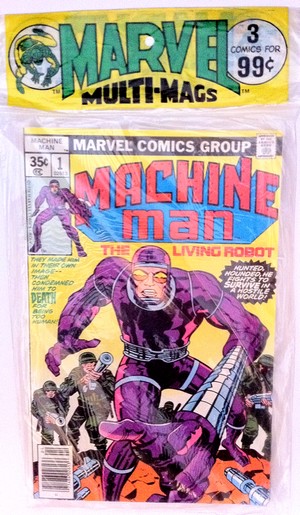 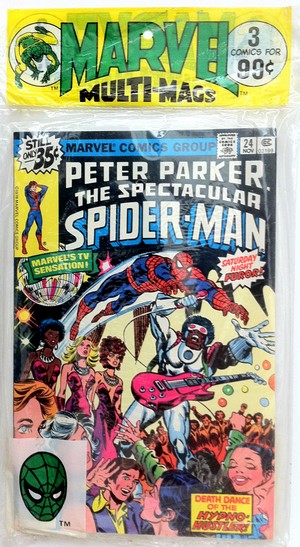 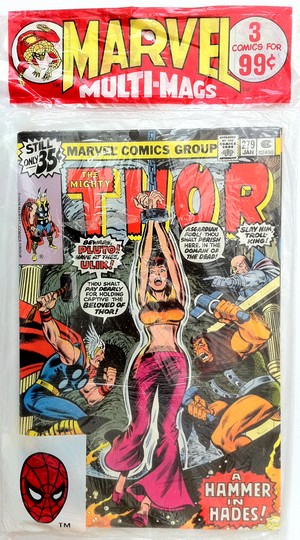 April 1978 / November 1978 / January
1979
|
| |
| When the cover price increased to
40¢ as of issues coverdated for
May 1979, the number of comic books in the Multi-Mags was
dropped to two - in all probability to stay below the
$1.00 mark. As a result, the formula now was "2 for 79¢". |
| |
1980
- 1983
TWILIGHT OF THE MULTI-MAGS
|
| |
| Distribution of comicpacks containing Marvel comics
through Whitman ended in April 1980. By that time, most
other comic pack programmes had fizzled out already. DC's
own setup was on its last lap, as were the Gold Key
(Western/Whitman) bags. The market had once again
changed, and now comics were hard to distribute to
supermarket venues too - besides, there was the direct
market forming. Marvel saw the potential, and in 1981
catered especially to the direct market when Dazzler
#1 was distributed exclusively to specialized comic
shops, thus bypassing the wider circulation market - a
first for the comic book industry. In
1982/83 Marvel found another distribution outlet in the
form of Parkes Run, who packaged and sold a wide
selection of comic packs branded MARVEL
COMICS which closely imitated the MULTI-MAGS
logo for a short time.
The comic pack, which had in many
ways pioneered the direct market, was now made redundant
by that very same market. It was the twilight of the
Marvel Multi-Mag, which had remained standing longer than
all other comic packs, but the sun would soon set on them
too - the last confirmed Marvel Multi-Mags proper went on
sale in early 1984; after that, the packaging of Marvel
comic books continued up until 1985, albeit under the
simplified labels MARVEL COMICS or COMICS FROM MARVEL BOOKS. Once again
holding 3 comic books (although now at a price of $1.69),
these were now handled by the new Marvel Books
division which had been set up in 1982 mainly to push
merchandising.
|
| |
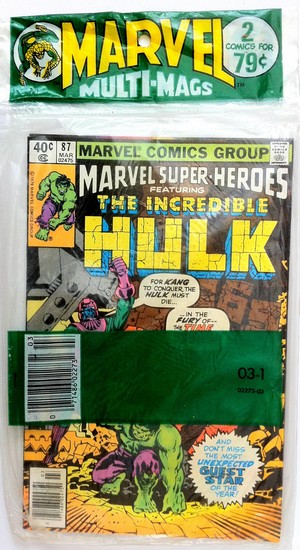 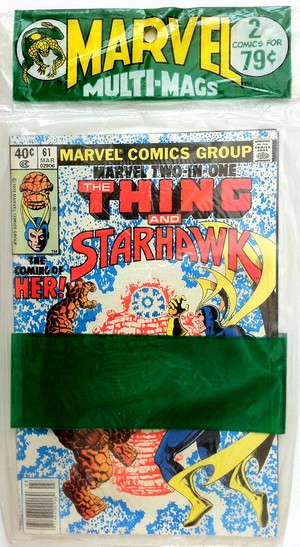 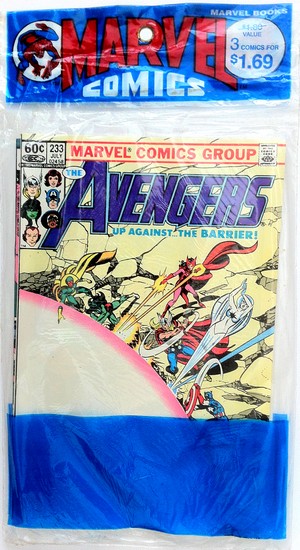 March 1980 (front side) / March 1980
(reverse side) / July 1983
|
| |
| Under the Marvel Books venture
the plastic bag concept was - literally - stretched to
its limit as the number of comic books rose, in a few
cases, to no less than 5 by 1984; at that point in time,
the white circle was left blank, thus showing no
suggested retail price (individual issues still sold for
60¢). Marvel Books
mostly went for themed bags anyway, and the mixed title
package soon gave way completely to Marvel's movie
adaptations such as Return of the Jedi or Dune
along with licensed properties such as G.I. Joe.
By 1985, however, the comicpack had lost all momentum and
just trickled away. |
| |
| An unexpected comeback happened
in the 1990s when the speculator's market focused
on comic book collecting. Several small companies
packaged inventory overstock from various eras
and sources in sealed plastic bags and sold them
through various discount markets as well as
Toys'R'Us. The latter
toystore chain sold "Marvel Comic Collector
2-Packs" for a while in the early 1990s,
which essentially combined one fairly current
(and most often fairly awful) title with one
Bronze Age title. Some company had obviously
gotten hold of a larger batch of 1970s warehouse
stock in excellent condition and was putting them
on the market this way in those pre-internet
days.
In more recent times,
Wal-Mart has collaborated with both DC and Marvel
to produce comic-packs containing multiple
issues, for sale exclusively at Wal-Mart stores.
CONCLUSION
In spite of leaving the
comic pack market between 1969 and 1972, Marvel
really made the concept work during the mid- and
late 1970s, with their comic books available in
multiple packagings and through a number of
distribution channels.
Admittedly a niche in the
history of Marvel Comics, but an interesting and
varied one.
|
|
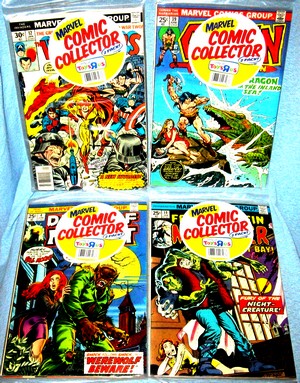 |
|
| |
| |
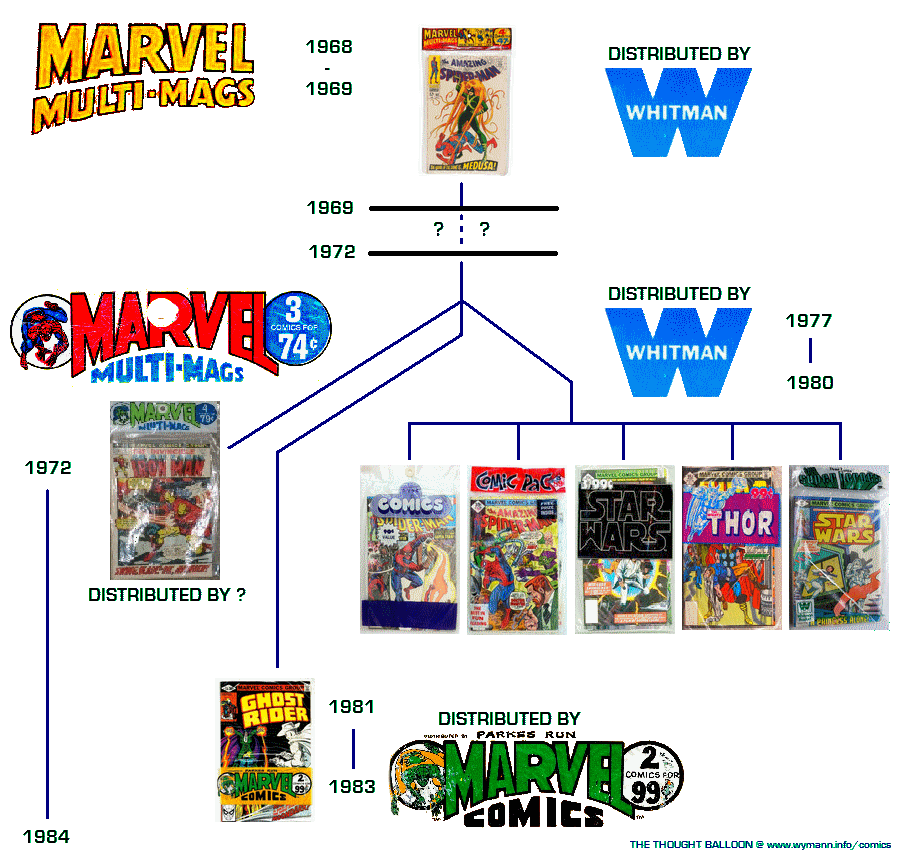 |
| |
| References DANIELS Les
(1991) Marvel: Five Fabulous Decades
of the World's Greatest Comics, Harry N. Abrams
EVANIER
Mark (2007) "More
on Comicpacs", published online in News
From Me
FOERSTER
Jonathan (2010) "Marvel Comics' miracle man
set up business' success", in Naples
Daily News, 30 May 2010
HOWE
Sean (2012) Marvel Comics - The Untold Story,
Harper Collins
LEE Stan
& THOMAS Roy (1998) "Stan the man & Roy
the boy: A conversation between Stan Lee and Roy
Thomas",
in Comic Book Artist #2
McCLURE
Jon Martin (2010) "A History of Publisher
Experimentation and Variant Comic Books", in
Overstreet Comic Book Price Guide, 40th
Edition, Gemstone Publishing
MORSE
Ben (2008) "Marvel Memories", published
online 30 May 2008 at marvel.com
NADEL
Nick (2009) "The Strange
Business History of Marvel Comics", published online
at Comics Alliance
SAUNDERS
Catherine, Heather Scott, Julia March
& Alastair Dougall (2008) Marvel
Chronicle - A Year by Year History, Dorling
Kindersley DK
SHOOTER
Jim (2011) "Roy Thomas saved Marvel", published online
at jimshooter.com
|
|
| |
First published
on the web 23 July 2014
updated 18 March 2015
minor revisions and updated 28 August 2021
minor revisions and updated 16 September 2023
revised and updated 2 June 2024
|

|
All characters,
logos, and images are the property of their current
copyright holders.
They are used here for non-commercial review purposes
which is considered fair use according to US Code Title
17, Sec. 107.
Text is
(c) 2014-2024 Adrian Wymann


|






































